June 2, 2017
Air Date: June 2, 2017
FULL SHOW
SEGMENTS
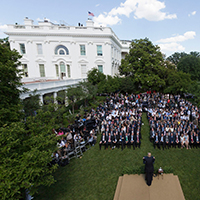
Trump Dumps Paris
View the page for this story
In a Rose Garden announcement, President Trump declared that the Paris Climate Agreement is a bad deal for the U.S. and would kill American jobs. But peer governments, businesses, scientists and American citizens are voicing fierce opposition to this decision. Alden Meyer of the Union of Concerned Scientists filled in host Steve Curwood on what Trump’s decision means for America and the world. (10:30)

Exxon Shareholders Vote Climate Assessment
View the page for this story
At ExxonMobil’s 2017 Annual Meeting, shareholders voted 62% to call on the world’s largest oil company to report the impact of international climate policies and threats on its business. Andrew Logan of the nonprofit Ceres tells host Steve Curwood that this historic decision is part of a broader shareholder movement of fossil fuel companies, as most countries embrace policies to limit climate change. (04:00)

Drought and Gender
/ Bobby BascombView the page for this story
Women often fetch water over long distances in Sub-Saharan Africa, and the current devastating drought is not only increasing hunger and disease, it is also creating more opportunities for violence against women. Living on Earth’s Bobby Bascomb reports. (07:10)

India, Coke, and Pepsi
View the page for this story
As the southern Indian state of Tamil Nadu struggles through its worst drought in 140 years, citizens are fighting Coca-Cola and PepsiCo bottling plants that tap into already scarce clean groundwater supplies. They create jobs but are seen as outsiders profiting from India’s resources. Keith Schneider, senior editor for on-line news site Circle of Blue, tells host Steve Curwood about the struggle for water between foreigners and citizens. (08:40)

India’s Renewable Energy Revolution
View the page for this story
Prior to the signing of the Paris Climate Agreement, few nations saw India as a leader in climate policy. But in 2015, the world’s third-biggest CO2 emitter began a breathtaking transformation, embracing renewable energy and slashing growth in carbon emissions. Now, the country of 1.3 billion people is a leader of clean energy in the developing world. International environmental reporter Stephen Leahy joins host Steve Curwood to trace India’s remarkable journey to green energy. (14:30)
Show Credits and Funders
Show Transcript
HOST: Steve Curwood
GUESTS: Alden Meyer, Andrew Logan, Keith Schneider, Stephen Leahy
REPORTER: Bobby Bascomb
[THEME]
CURWOOD: From Public Radio International, this is Living on Earth. I'm Steve Curwood. President Trump is pulling the U.S. out of the Paris Climate Agreement to a chorus of criticism.
MEYER: Clearly he doesn’t understand what’s in the agreement, how it works, the notion that he’s going to get anyone to join him at the table to renegotiate this deal is laughable if it wasn’t so sad. It’s cover for an unwillingness to do anything that discomforts his friends in the coal and oil industry.
CURWOOD: Meanwhile, the majority of ExxonMobil Shareholders have called on the oil giant to come clean about climate risks.
LOGAN: You know, we're witnessing a historic shift in how investors look at climate change and climate risk. The biggest investors in the world are now willing to challenge their largest holdings around what is now seen as a core financial issue in climate change.
CURWOOD: That and more this week on Living on Earth. Stick around.
[NEWSBREAK MUSIC: Boards Of Canada “Zoetrope” from “In A Beautiful Place Out In The Country” (Warp Records 2000)]
[THEME]
Trump Dumps Paris
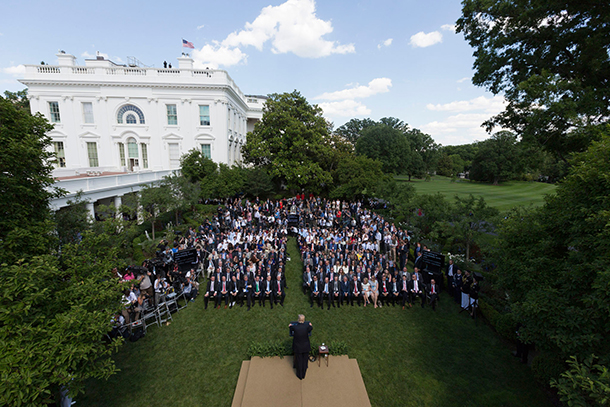
President Trump addressed a small crowd in the Rose Garden on June 1st. (Photo: Official White House Photo by Joyce N. Boghosian)
CURWOOD: From PRI, and the Jennifer and Ted Stanley Studios at the University of Massachusetts Boston, this is Living on Earth. I’m Steve Curwood.
President Trump declared June 1st that the United States is withdrawing from the Paris agreement to address global warming, leaving more than a 190 nations behind, who still agree, and joining two others that don’t -- Syria and Nicaragua. And Nicaraguan delegates say they didn’t like the deal because it didn’t go far enough to protect the planet. President Trump campaigned against the Paris accord, and despite pleas to remain from many other governments, businesses, scientists and active citizens, he went to the Rose Garden to fulfill his pledge.
TRUMP: As President, I have one obligation, and that obligation is to the American people. The Paris Accord would undermine our economy, hamstring our workers, weaken our sovereignty, impose unacceptable legal risk, and put us at a permanent disadvantage to the other countries of the world. It is time to exit the Paris accord. [APPLAUSE]
CURWOOD: To explain what that means for the US and the planet we turn now to Alden Meyer, who is director of strategy and policy for the Union of Concerned Scientists. Alden, welcome back to Living on Earth.
MEYER: Glad to be with you again, Steve.
CURWOOD: And as I recall, you've been following the international climate negotiations for, what, 27 years?
MEYER: That's right. The original negotiations leading up to the Rio treaty in 1992 and then on to Kyoto and Bali and Paris, and here we are.
CURWOOD: So, what's your reaction to President Trump's decision to withdraw the United States from the Paris agreement?
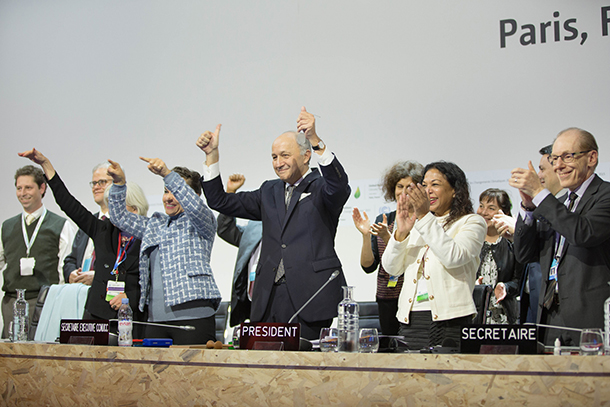
UN climate change leaders shared a moment of joy at the establishment of the landmark international climate agreement in Paris, France, December 12, 2015. 195 nations have signed onto the agreement. (Photo: UNclimatechange, Flickr CC BY 2.0)
MEYER: Well, it's a very sad day. It's a reckless decision. He sold it with a mix of half-truths and outright lies about what Paris is, what it does, what its implications are for the United States. Clearly, he doesn’t understand what's in the agreement, how it works, the notion he's going to get any country to join him at the table to renegotiate this deal is laughable if it wasn't so sad. The reality is, it's cover for an unwillingness to do anything that discomforts his friends in the coal and oil industry and hurt short-term profits, and the irony is it comes at the expense of the very voters that put him in office and that he purports to represent. The impacts on climate change are just as serious in Paris, Kentucky, as they are in Paris, France, and the mayor of Pittsburgh has already responded that he intends to keep pushing forward with climate action in Pittsburgh to try to generate clean energy jobs for people that are unemployed in Pittsburgh. So, it's misleading, and really it's a sad day and it's going to have a devastating impact on America's reputation around the world and the administration's ability to get much done on other issues they care about, where leaders would have to make what would be seen as concessions to this president in front of their own voters.
CURWOOD: Now, President Trump made a big point of saying that the Paris agreement is unfair to the United States. So, to what extent is he accurate in that analysis?
MEYER: Well, again, it just shows how little he understands about it. As you know, Steve, Paris asked countries to put forward their own commitments - what they thought they could do, what they thought was fair. There was no analysis or comparison of those, no scorekeeping, no negotiations, and backroom bunkers the way there was in Kyoto, for example, between the European Union, Japan, and the US on the famous Kyoto targets. So every country put forward what they thought was fair from their point of view, and all those proposed commitments were accepted and embodied in the Paris agreement with the understanding that everyone was going to have to come back to the table and do more down the road if we were going to meet the temperature limitation goals in Paris, which are quite ambitious.
So, the president just doesn't understand what the meaning of word “fair” is. There are also outright myths and lies about what countries like China and India have to do. The notion that because China took on a target to stabilize its national emissions in 2030 means they get a free pass or a free ride for the next 15 in years is laughable. China has to do a yeoman's work to the carbonize its electricity sector, invest in renewable energy -- electric vehicles, to meet what is a fairly ambitious target. The good news is China appears to be well ahead of schedule and will peak their national emissions well before 2030, but the notion that somehow that was unfair to the United States and China had to do nothing is just absurd.

Protestors gathered in front of the White House after President Trump’s announcement that he will pull the United States out of the Paris Agreement. (Photo: Public Citizen)
CURWOOD: Now, a technical question for you, Alden. As I understand it, the rules of the Paris agreement require four years for a party to get out. So, what does this mean, in terms of what President Trump has said? What's he going to do for these next four years, if I have that right?
MEYER: Well, you're right, Steve, a country has to wait until three years after entry in the force of the Paris agreement, which was early November of last year before they can formally notify the Secretary General of United Nations of their intent to withdraw, and then they have to wait one year after that to actually formally withdraw. So, the irony here is the first day that President Trump could legally withdraw the United States from the Paris agreement is the day after the 2020 presidential election in November. So, there's this notion that we're pulling out. It really doesn't mean anything. It's all drama and show and a lot of noise signifying nothing.
CURWOOD: So, we will continue to be part of the Paris accord -- we being United States -- but what kind of legitimacy will we have in the process and how will this affect us in the broader negotiations, the framework convention on climate change? The conference of these parties is in Bonn this next November. We haven't pulled out of the framework convention. What kind of legitimacy do we now have in this climate negotiation process?
MEYER: Well, I think almost none, or I would say probably none. I mean, technically, yes, we have a right to be at the table, but now the president has formally disavowed Paris and dissed the rest of the world, really doesn't understand what the agreement is, claims it's unfair to the US, wants to renegotiate it. I don't think people are going to want to have too much to do with the US delegation at these talks.

A sign from the protest following President Trump’s announcement. Critics of President Trump’s decision say that in withdrawing the U.S. from the Paris climate deal, Trump disregarded science and sought to please friends in the fossil fuel industry. (Photo: Public Citizen)
And, of course, Paris was the culmination of 25 years of work under the framework convention adopted in Rio, so the notion that you can disavow this truly global effort to come to grips with the climate crisis and then pretend to be concerned about climate change and come to the meetings and participate actively I think will be rejected. I think that the US will be treated like a pariah at these negotiations for the next four years unless there is an about-face by the president before his term is up.
CURWOOD: Alden, how much of a blow to developing countries is President Trump's halting of US payments to the green climate fund?
MEYER: Well, there's two factors there, Steve. One is, we don't yet know how Congress is going to respond to the President's proposed budget and, of course, under our constitution, unless the President decides to ignore it, he does not have the power of the purse. “The president proposes, Congress disposes," is the famous phrase, and there's already been indications from both Republicans and Democrats on the Hill that they reject the deep cuts in foreign aid, including in climate and energy assistance that the administration has put forward.
The other factor we don't know is how much will other countries -- both the other developed countries like Germany, Japan, United Kingdom, France, as well as other major countries like China, which are now in the development finance game -- how much will they do to try to make up some of the shortfall created by whatever the US ends up doing. But there's no doubt that the US will not be doing our fair share of the lift here. We had a big role in creating this problem with our past emissions. On the impact side, we have a responsibility to help those countries deal with those impacts.
It's also in our economic and security interest to help developing countries grow their economies in a different way than we did because if they replicate our fossil fuel intensive development path of the 1800s and 1900s, it's game-over in terms of the climate. So, we have self-interest as well as ethical obligations at play here, and luckily there are a number of thoughtful Republican members and senators on the Hill that understand that.
CURWOOD: Alden, how optimistic are you about the rest the world carrying forward with Paris?

The other leaders in the G7 – seen here at the Taormina, Italy meeting on May 26, 2017 -- attempted to persuade President Trump to keep the U.S. in the Paris Agreement, but their efforts ultimately failed. (Photo: Italian Presidency of the Council of Ministers, Wikimedia Commons CC BY 3.0 IT)
MEYER: I'm very optimistic that there will not be any exodus from the agreement. You haven't seen a single country say they would join President Trump in withdrawing from the agreement. I also don't think I see any indications that the major emitting countries are going to pull back or reconsider the commitments they made under Paris. Much, much the opposite actually. Countries like China, I think, are recognizing that they can up the formal commitments made under Paris because they're so well ahead of schedule in meeting them. I think the concern could come down the road in two or three years when we get to the point where countries have to be thinking about their next round of commitments or what they can do to revise their 2030 commitments if they're one of the countries that took on the longer-term obligation, and there you might have an argument being made by some in some places that, “Why should we be considering doing more if the world's largest economy and second largest polluter is saying they won't do anything or much less?”
But I think the reality of climate impacts and extreme weather events and the cost of those is concentrating mines in Delhi and Beijing and Brasilia and other world capitals as well as the plummeting cost of solar wind and other clean technologies is making it clear that, even putting climate change aside, the low carbon pathway is least cost route to develop your economy. I think those two trends will blow away any sort of geopolitical impact of what President Trump did today.
CURWOOD: Alden Meyer is Director of Strategy and Policy for the Union of Concerned Scientists. Alden, thanks so much for taking the time with me today.
MEYER: Glad to be with you, Steve.
Related links:
- Watch: President Trump Makes a Statement Regarding the Paris Accord
- Washington Post: “Fact-checking President Trump’s claims on the Paris climate change deal”
- The New York Times Opinion Pages: Outrage Over Trump’s Climate Decision
- Watch: French President Macron says: “Make Our Planet Great Again”
- The Guardian: “Pittsburgh fires back at Trump: we stand with Paris, not you”
- The Guardian: “Obama condemns Trump for ‘rejecting the future’ by exiting Paris climate deal”
- Greenpeace: “10 things you want to ask about Trump’s withdrawal from the Paris Agreement”
- Resistance Report: “Trump Cited MIT Research to Justify Pulling Out of Climate Accord. MIT Responds.”
[MUSIC: Grace Feldman, “Byrd one Brere (Bird On a Briar)” from The Revels Seasons for Singing-A Celebration of Country Life, 13th Century English, Revels Records]
Exxon Shareholders Vote Climate Assessment

ExxonMobil is the largest oil company in the world (Photo: Michael Rivera, Wikimedia Commons CC BY-SA 3.0)
CURWOOD: Well, despite President Trump’s decision to pull the US out of the Paris climate agreement, investors in the oil giant ExxonMobil have raised the ante for climate action. ExxonMobil shareholders recently handed a stunning defeat to management at its recent annual meeting, voting by some 62 percent to call on it to reveal its climate-related risks. A similar shareholder resolution last year won just 38 percent of the vote.
So we called up Andrew Logan, Director of Oil and Gas programs at the nonprofit business sustainability group Ceres for some insights. Welcome back to Living on Earth, Andrew.
LOGAN: Thanks for having me.
CURWOOD: So, how significant is this? What does it exactly call on Exxon to do?
LOGAN: This is historic. I mean, this year for the first time, we're seeing investors cast majority votes calling on companies in oil and gas and power sectors to assess and disclose how they're preparing for a low-carbon future. So, prior to this year, I would say a vote in the 30 percent, 40 percent range would be considered over the top, but now we are seeing a majority vote at companies ExxonMobil to Occidental to PPL.
CURWOOD: So, what do you think Exxon will do now that the shareholders have voted this way?

The floor of the New York Stock Exchange. (Photo: Kevin Hutchinson, Flickr CC BY 2.0)
LOGAN: Well, I mean they clearly have to do something, and it's not just because the vote was as high as it was -- That's obviously significant -- but that the very largest owners of Exxon stock … So, the three largest holders of the company all voted in favor the proposal. So, I think that it is very hard for a company, even a company as large and stubborn as ExxonMobil to go against its core investors in that way.
CURWOOD: So, Andrew, why was there a big jump in support for the shareholder resolution calling on Exxon to analyze its climate costs compared to last year's vote which was down around, what, 38 percent?
LOGAN: So, what we've seen is that the very biggest investors in this company and in most companies -- I mean BlackRock and State Street are the largest investors in almost every company on Earth just because of their size -- They have now come to see climate change as not just an environmental issue, but really as a material financial issue. And so, they're now voting in support of these proposals in a way that they hadn't in the past. And what's interesting about the three funds, BlackRock, Vanguard, and State Street is they are largely index funds, which means they can't sell the stock. They're stuck with it in perpetuity. And so, if you're stuck owning stock until the company goes away, you have a very strong vested interest in making sure the company sticks around as long as possible.
CURWOOD: Now, this vote by Exxon shareholders came after an investigation into what Exxon was telling investors about its climate risks. That was done by Inside Climate News in collaboration with Columbia University and also the Los Angeles Times, and now I guess Exxon is still under investigation by several states attorneys general for potentially misleading shareholders about climate risk to the company. To what extent do you think that publicity played a role in the way that shareholders voted on this resolution?
LOGAN: I mean, it's a good question, and it's a bit hard to say, but certainly Exxon's history on climate change has not done much to build trust with investors. Sometimes a vote is as much about how much investors trust management as it is about the issue under question. So, I think one way to look at the vote today is that investors by and large don't trust this company and the way it's being run.
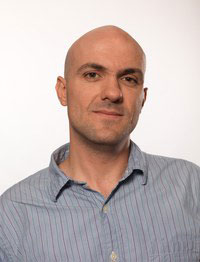
Andrew Logan is the director of the Oil & Gas and Insurance Programs at Ceres. (Photo: Ceres)
CURWOOD: It's annual meeting time, and Exxon isn't the only major oil company, fossil fuel energy company, where shareholders voted to pressure to analyze climate risks. We have Occidental Petroleum and PPL, which is the largest utility in Pennsylvania. There were also majorities for similar resolutions there. What's going on?
LOGAN: I mean, I think what's going on is we're witnessing a historic shift in how investors look at climate change and climate risk. Occidental and PPL were the first majority votes for these kinds of proposal that we've seen. So, I think what's happening is that the biggest investors in the world are now wanting to challenge their largest holdings around what is now seen as a core financial issue in climate change, and that's a very different place than we were even a couple of years ago.
CURWOOD: Andrew Logan is Director of Oil and Gas Programs at the nonprofit Ceres. Andrew, thank you so much for taking the time today.
LOGAN: You're quite welcome. Thank you for having me.
Related links:
- InsideClimate News: “Exxon Shareholders Approve Climate Resolution: 62% Vote for Disclosure”
- ExxonMobil asked Trump to keep U.S. in the Paris climate deal
- 2017 Exxon Annual Meeting Proxy Statement with Shareholder Resolution
- LOE interview: “Exxon Denied its Own Climate Research”
- LOE interview with Andrew Logan about the SEC’s investigation of Exxon
[MUSIC: Andanzas, “El Dia Que Tu Te Fuiste (The Day You Left)” on More Songs Of Latin America, composed by Antonio Caban Vale, Northeastern Records]
CURWOOD: Coming up, conflicting priorities, jobs and scarce water resources. Stay tuned to Living on Earth.
ANNOUNCER: Support for Living on Earth comes from the Gordon and Betty Moore Foundation, and from a friend of Sailors for the Sea, working with boaters to restore ocean health.
[CUTAWAY MUSIC: Andanzas, “Harpa Vallenata (Vallenata Rhythm for Harp)” on More Songs Of Latin America, composed by Alfredo Rolando Ortiz, Northeastern Records.]
Drought and Gender
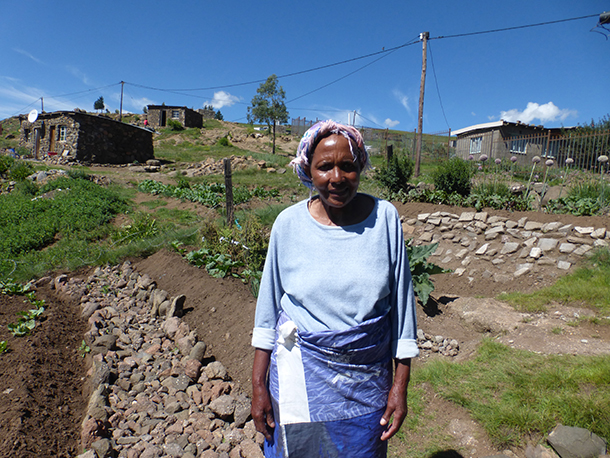
Nasetnaka Ramatse outside her home in Thaba-tseka, Lesotho. (Bobby Bascomb)
CURWOOD: It’s Living on Earth. I’m Steve Curwood. Drought is stalking parts of Sub-Saharan Africa, as the climate warms, and weather patterns shift. Crops shrivel in the field and livestock die, making the drought a crisis in some areas. For much of the Horn of Africa the seasonal rains have largely failed for the last two years, devastating the region where as many as 17 million people face starvation. For Southern Africa the seasonal rains still come but they arrive late and end early, leaving rural people struggling to find enough water for their households, animals and crops.
As Living on Earth’s Bobby Bascomb reports women are usually the ones who have to fetch water, and in this time of scarcity they are particularly vulnerable.
[COW MOOS, GOATS, BELLS RINGING, HERD SOUNDS]
BASCOMB: A herd of goats, sheep, and cows ambles up a steep mountain road in the tiny country of Lesotho. A shepherd wrapped head to toe in a wool blanket and hat rides alongside on a horse, leading the animals towards a stream for their daily drink.
[HERD SOUNDS]
BASCOMB: Lesotho is an extremely mountainous country, completely surrounded by South Africa. With little flat land for growing food, the majority of people here depend on livestock for their food and income. In times of drought that means herdsmen may spend the majority of their day bringing animals to water. It’s a hard life, but the real burden of drought falls disproportionately on women, like 66 year-old Nasetnaka Ramatse. She stands tall and straight in a colorful wrap outside her small stone house clinging to the side of a mountain. She’s a retired office worker and keeps a tidy garden when there’s enough rain.
RAMATSE: Men and women don’t play the same role. So men didn’t feel that drought as women did because men are not drawing water. They just want to eat. [LAUGHS] So, women are the ones that feel the drought.
BASCOMB: Across the continent it is solely the responsibility of women to collect water and bring it home for drinking, cooking, and cleaning.
RAMATSE: It’s our culture. If you go to the well other men will be laughing at you. They will say, [Speaks Sotho. LAUGHS.] “Your woman has given you something to tame you.” [LAUGHS] They want to wash. They want to have clean clothes, to have food, but from where they get the water they don’t care.
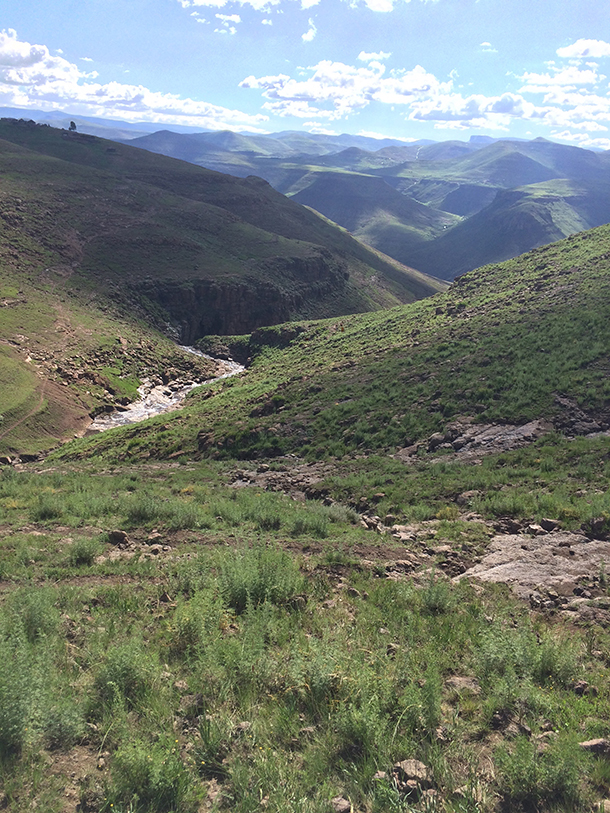
The mountainous highlands of Lesotho. (Mark Fabian)
BASCOMB: To get water Ramatse has to walk an hour from her tiny village to town, wait for two hours to fill her jugs, and then walk an hour back up a steep mountain to her house.
RAMATSE: When I come back I am hungry, and there is no food I have to start again and cook. I’ll have to wash, you see, I’m having a grandchild. After washing himself, I’ll have to use that water to wash myself in order to save. That day I won’t do anything except cooking and eating because I will be tired from drawing the water. It affects my day, because my day will pass without doing anything. So, two days, three days will pass then I’ll have to go again.
BASCOMB: In other parts of Africa the drought has been even more personally devastating for women. Asli Mohamoud is an aid worker with Care International in Somalia, where the drought is already causing displacement and widespread famine. She says, before the drought women had a two-mile round-trip journey to get water. But now, because water sources have dried up, they must walk as much as 30 miles to get water for their households. Along the way, Asli says women and girls are extremely vulnerable to exploitation and sexual violence.
MOHAMOUD: In that journey you’ve got women walking alone. There’s no protection. They meet men. Either they tell false and say, “I will marry you or I do this,” and then they use her or they rape her.
BASCOMB: Across much of the region rape comes with a social stigma that keeps many victims silent ... or worse. Asli recounts the story of a 16 year old girl who was raped by an older man.
MOHAMOUD: She lost her virginity, she lost everything. She lost hope. I tell her, I say “This is not your fault this happens all over the world. Don’t lose your hope, continue your life.” Now she is fine but before she meet with me and my team she decided to kill herself.
BASCOMB: Asli says she’s seeing a sharp increase in early marriage for girls. Families will choose to marry off their daughters to have one less mouth to feed at home. Or girls may choose to migrate to cities like Baidoa, north of the capitol Mogadishu, in search of survival.
MOHAMOUD: When they come to the urban areas they don’t have any means. They don’t have any skills. They don’t have education. So, the only option she have is to marry a man to survive. I see 16, 14, 15, that’s common to marry.

A herd of animals amble up a mountain road in Lesotho. (Mark Fabian)
BASCOMB: As a result, the average age for a girl’s first sexual encounter has dropped significantly. CARE International reports that in Mozambique in 2003, for example, girls’ first sexual experience came at around age 16. But since the drought began it’s closer to 11 or 12. That brings particular danger for childbirth, should the girl become pregnant.
CARE says they’re also seeing a sharp increase in HIV rates. In rural areas where HIV is endemic the rate of infection increases by roughly 11% with every drought, a fact that’s attributed at least in part to earlier sexual encounters and sexual assault. Aid worker Asli says the drought and the struggles women face are personal for her.
MAHAMOUD: I am a Somali woman, and I’m feeling what all Somali women are feeling. Because I am a woman, I am a mother, I’m a wife, I’m a sister, an aunt. So, I like to support ... I like every girl to get her rights.
BASCOMB: But that may not happen. Persistent drought might become the new normal for much of Sub-Saharan Africa. The Intergovernmental Panel on Climate Change predicts that much of the region will become hotter and drier in the future with a changing climate. The seasonal “long rain” should be falling in East Africa now, between March and June. So far, the rains have been disappointing and sporadic leading to fears that the punishing drought will continue. Still, some forecast models are predicting that the end of the rainy season, June, will bring near average rainfall. People across the region, especially women, are praying they are right.
[WOMEN SINGING]
For Living on Earth, I’m Bobby Bascomb in Thaba-tseka, Lesotho.
[WOMEN SINGING]
Related links:
- CARE International Report: Hope Dries Up
- Southern Africa Fact Sheet
- More from Bobby Bascomb on the drought in sub-Saharan Africa
India, Coke, and Pepsi

Coke and Pepsi are ubiquitous in Tamil Nadu food and beverage shops. (Photo: courtesy of Keith Schneider)
CURWOOD: Drought is also a perennial problem in parts of India, especially in the south, and now the state of Tamil Nadu is experiencing its worst drought in 140 years. While citizens struggle to meet their daily water needs, the American-branded beverage companies Coke and Pepsi have become a focus of concern.
Keith Schneider is Senior Editor and Chief Correspondent at the environmental news website Circle of Blue and has reported on this struggle for water. Keith Schneider, welcome back to Living on Earth.
SCHNEIDER: It’s nice to be back. Thank you, Steve.
CURWOOD: So, tell me -- where is Tamil Nadu? What's it like in the big city there, Chennai, right?
SCHNEIDER: Chennai, which is a metropolitan area of 10 million people and the fourth-largest metropolitan region in India. Tamil Nadu, in southern India in a state of 78 million people and over 1,000 kilometers of coastline on the Bay of Bengal, has had tremendous threats from ecological disturbances and meteorological disruptions over the last several years.
CURWOOD: What's the problem now with the drought?
SCHNEIDER: Chennai and Tamil Nadu have episodic droughts every year because there are two monsoons or were two monsoons, one in the fall and one in the late spring. And between those monsoons and typically in other years there were dry years, and those dry years are now extending and in this case for two years. So, the drought is crippling industrial companies. It's become a serious impediment to the quality life all over Tamil Nadu ... long water lines, municipalities are shutting off water to their customers weekly now, in some cases. Water is not something that is taken for granted at any time by anybody in Tamil Nadu.
CURWOOD: So, talk to me about the history of Coke and Pepsi in this now very dry region.
SCHNEIDER: Well, Pepsi Cola and Coca-Cola had been active in India up until 1970 when the industry was nationalized, and they left. Pepsi came back in 1989 to establish a new plant, and Coca-Cola followed in 1991, and things were relatively peaceful until 2002.

Lines to refill water containers, like this one in Tamil Nadu, have been common in recent months. (Photo: courtesy of Keith Schneider)
Coca-Cola built a plant in Kerala, a southern Indian state that borders Tamil Nadu, and during a drought and farmers and their wives protested and blocked the entrance to the plant and said that Coca-Cola had no sort of moral authority to be privatizing scarce water resources, and this is water that they thought was being taken from their crops, and they protested and the state of Kerala totally shut the plant down in 2004, and it never opened.
And it sort of opened up this moral threat -- that Indian residents found a moral threat from American-branded companies to take water, privatize what they viewed as a public resource, and it has spread. Since 2014, there have been six plants -- Coca-Cola and Pepsi plants that have been shutdown -- and there is very significant public support for being very tough on these American-branded bottlers.
CURWOOD: And remind us, these are American intellectual property rights to brand Coke or Pepsi, but how much of this is actually owned locally by Indians?
SCHNEIDER: Most of the plants are owned locally by Indian bottlers. Coca-Cola has, as of 2015, 57 bottling plants -- it has less now because they closed three last year. And Pepsi in 2015 had 37 plants, most of them owned by Indian families.
CURWOOD: So, what's the argument of Pepsi, and Coke as well, as to why they should be allowed to the harvest this water?
SCHNEIDER: One interesting thing here is that neither Coke nor Pepsi would answer my questions like that. So, I can suggest what they would say, based on my reporting, and what they might is one, they have a right to this water just like any industry in Tamil Nadu has a right -- smelters use water, tannerys use water, beer makers use water, why should Coke and Pepsi be singled out not to be able to take advantage of a resource that's so essential to their product line? Two, that Coke would argue that in taking this water that it's going to replace every drop that it takes somewhere in Tamil Nadu as part of its global water conservation program. And three, they would say that they’re a private company, or public companies that have a right to make money off what they do, which is to make drinks. And the last piece they would say is that they are employers, so they have good jobs in nonpolluting plants -- these plants don't pollute very heavily -- in a state in which good jobs that are in nonpolluting industries are necessary.

Protests have resulted in Coca-Cola and Pepsi plants shutting down, but citizens continue to organize as more plants are built. (Photo: Knut-Erik Helle, Flickr CC BY-NC-ND 2.0)
CURWOOD: And the flipside and the argument is, “Wait, this the public's water, and now you are going to take it, privatize it, put a profit in it when the situation is desperate. This is outrageous.”
SCHNEIDER: Well, the American bottling issue in Tamil Nadu is interesting to me because on the one hand, an American-branded company taking water, privatizing water for their private gain. But at same time, Tamil Nadu residents say almost nothing about the extensive pollution in their rivers, the industrial pollution by Indian plants and the lack of sewage treatment. So rivers in Tamil Nadu as in much of the West, are filthy.
So, there's this bifurcated debate. On one side, the American companies are easy targets for social activism around privatizing water and what is viewed as a foreign intrusion in their culture, and on the other side there's very little comment on the extensive water pollution which actually is ruining much more water than what the bottled water is taking from rivers and groundwater in Tamil Nadu.
CURWOOD: So, I take it at the end of the day this issue is more about environment versus profits and outsiders versus natives.
SCHNEIDER: That's a big piece of it, and the other piece of it is that in India -- rural India in particular -- the idea that big companies, big foreign companies can just descend on these areas with their major plants and do as they wish -- that era over.
CURWOOD: Why are Coke and Pepsi so determined to get into these markets?
SCHNEIDER: Well, Coke and Pepsi are multi-billion dollar companies that need to expand their markets, and in the West, sales of Coca-Cola and Pepsi are descending, are diminishing and the business plan for both companies was to expand principally in Asia. It's not working very well, despite multimillion dollar marketing campaigns and both companies have initiated some pretty significant water conservation measures. Coke uses less water than it ever did before, and it says it's replenishing every drop that it uses. This hasn't convinced its critics.

Keith Schneider is senior editor and chief correspondent at Circle of Blue. (Photo: courtesy of Keith Schneider)
CURWOOD: So, the protesters here have been successful at being able to shut down some of these plants in the past few years. Look the future. What do you expect to see happening ahead?
SCHNEIDER: Um, I think Coke and Pepsi are going to have trouble, I really do, because water is becoming much more scarce around the world. Groundwater in Chennai is an asset that is closely watched now because a good deal of it is polluted, so the clean water is seen as a valuable natural resource to be protected, and that wraps into this whole Coke and Pepsi thing because they’re, they're tapping clean water, clean groundwater, not polluted groundwater. So, they're seen as tapping the best that Tamil Nadu has to offer in its water resources, which plays into this resistance that private companies are privatizing a public resource.
CURWOOD: So, Keith, how much of an example to activists here in United States is the resistance to Coke and Pepsi there in India?
SCHNEIDER: Well, civil resistance in India looks much different than civil resistance in the United States. People can gather very quickly in India to protest. There seems to be much more flexibility in their schedules to be able to protest, and they’ll stick at it for weeks and weeks and weeks and weeks at a time. In Kerala, where the first Coca-Cola resistance began around a plant, those protests lasted a year. People showed up at the plant gates every morning by the hundreds for well over a year before the district decided to act, and the state shut the plant down.
Very impressive to watch an Indian protest, the way it built over the week from a tiny protest and how it spread, working in the institutions of the various associations, the business associations, the teachers' unions. It was amazing how it just built and built and built into this tremendously joyous festival of cultural grievance.
CURWOOD: Well, Keith, I want to thank you for taking the time with me today. Keith Schneider is Senior Editor and Chief Correspondent at the environmental news website Circle of Blue. Thanks so much.
SCHNEIDER: Thank you, Steve.
Related links:
- Circle of Blue: “The Right to Life and Water: Drought and Turmoil for Coke and Pepsi in Tamil Nadu”
- Straits Times: “Drought grips southern India, set to worsen in summer”
- Circle of Blue: “In City Prone to Drought, Chennai’s Water Packagers Rush In”
- Coca-Cola India
- Pepsico India
[MUSIC: Muzsikas, “Azt Gondaltam, Eso Esik (I Thought It Was Raining)” on The Prisoner’s Song, Hannibal Records/Carthage Records, under license from Hungaroton Records]
CURWOOD: Coming up, India is amazing citizens and investors alike with a massive renewable energy program and no new coal power plants. That’s just ahead here on Living on Earth. Stay tuned.
ANNOUNCER: Funding for Living on Earth comes from you our listeners, and United Technologies -- combining passion for science with engineering to create solutions designed for sustainability in the aerospace, food refrigeration and building industries. UTC companies such as Otis, Carrier, Pratt & Whitney and UTC Aerospace Systems are helping to move the world forward.
This is PRI, Public Radio International.
[CUTAWAY MUSIC: Leigh Howard Stevens, “Sonata in b-minor, S.1003, Allegro” on Leigh Howard Stevens Plays Bach on Marimba, Johann Sebastian Bach/arr. Stevens, Resonator Records]
India’s Renewable Energy Revolution
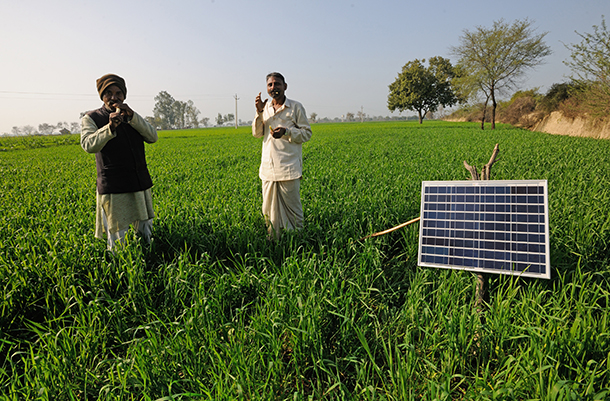
Gopal Singh and Kishen Lal install a solar panel in Mathura, a city in northern India, in 2014. The sprawling nature of the country makes massive centralized power projects costlier and less efficient than smaller, localized power sources. (Photo: Asian Development Bank, Flickr CC BY-NC-ND 2.0)
CURWOOD: It’s Living on Earth, I’m Steve Curwood. For years, India has been reluctant to address limits on global warming gas emissions, citing the need to advance development with coal. But in 2015, when India came to the climate talks in Paris, Prime Minister Narendra Modi spearheaded the launch of an international solar alliance to raise $1 trillion to light up the developing world, and Living on Earth was there.
[INDIAN MUSIC]
MODI: Today, the world must turn to sun to power our future. As the developing world lifts billions of people into prosperity, our hope for a sustainable planet rests on a bold global initiative. The vast majority of humanity is blessed with generous sunlight round the year. Yet, many are also without any source of power. This is why this alliance is so important. We want to bring solar energy into our lives and homes by making it cheaper, more reliable, and easier to connect to grid.
CURWOOD: The alliance will develop best practices and common regulation, stimulate investment and solar product development, Modi said, and will become the foundation of the new economy.
MODI: This is an alliance that brings together developed and developing countries, governments and industries, laboratories and institutions, in a common enterprise. This day is the sunrise of new hope, not just for clean energy, but for villages and homes still in darkness, and for more mornings and evenings filled with the clear view of the glory of the sun. Thank you very much.
[APPLAUSE]
CURWOOD: And now some 18 months later, India’s Prime Minister has turned promise into action at home turning his country of 1.3 billion people into perhaps the world’s best example of the revolution in green energy. International environmental reporter Stephen Leahy has been following this remarkable transition in India, writing about it in National Geographic. Welcome to Living on Earth.
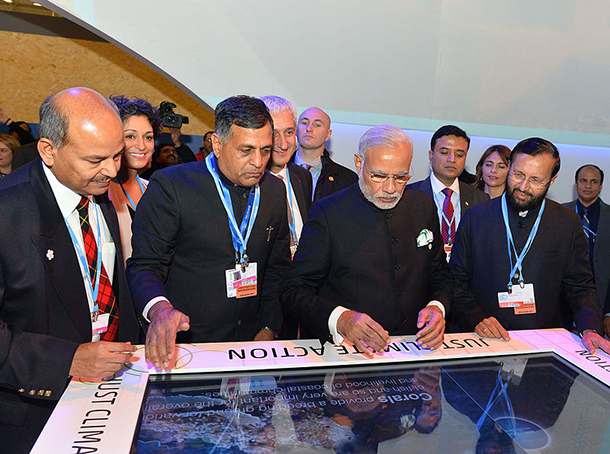
Prime Minister Modi (third from left in the front row) visits the Indian delegation at the 2015 UN Climate Change Conference in Paris. Modi used the talks as a platform to unveil India’s ambitious renewable energy goals. (Photo: Narendra Modi, Wikimedia Commons CC BY-SA 2.0)
LEAHY: Great to be here.
CURWOOD: So, Prime Minister Modi made a big promise at the Paris climate talks to bring solar energy to India and indeed the developing world. To what extent are we seeing that promise actually being carried out here?
LEAHY: Well, I think it's happening faster than anybody expected because it was a gigantic promise. Many people were skeptical that they could deliver, but in just these last two years, they have done remarkable things in terms of creating a new approach to bringing energy to an awful lot of people. A lot of people thought that even if they did try and do it, they couldn't do it this quickly. The perception about India may be that it's a bureaucratic government that takes a long time to make decisions, that there's lots of red tape, but that seems not to be the case when it comes to this.
CURWOOD: You have been covering this for a long time, Stephen. How does this story feel? How exciting is this?
LEAHY: Yeah, I've probably been more excited about this that I have about anything in the last few years since Paris really. Paris was a big development, but that was talk. Now, India is delivering on the ground.
CURWOOD: For the record, how vulnerable is India to climate change?
LEAHY: Yeah, they're one of the most vulnerable countries. They've got water problems, water shortages. They've had huge heat waves that killed hundreds of people. They've got the sea level rise issue with most of the coastal areas. There's threats to their monsoon, which their agriculture is completely dependent upon. So, there's a whole range of real impacts already happening to India right now, and it's only going to get worse in the future.
CURWOOD: Now, as I understand it, there are more than a billion people in India and some 300 million who have no access to electric power. What are the biggest challenges to providing universal electricity access in India?
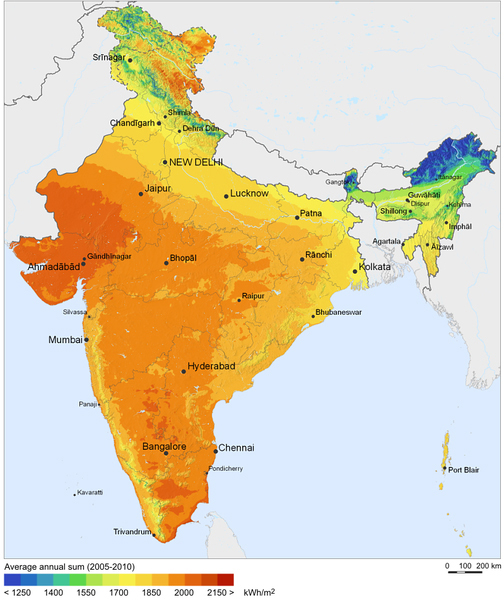
Most of India receives relatively high levels of sunlight, and has tremendous potential for solar power development. (Photo: SolarGIS GeoMode, Wikimedia Commons CC BY-SA 3.0)
LEAHY: One of the biggest problems is the cost. There are lots of small villages spread out over a very large country, and these are poor people who can't afford to pay very much for electricity. So, the beauty of renewable energy is it's cheaper and it's decentralized as much here to install a small solar panel set up or a couple of wind turbines to provide energy in really remote areas.
CURWOOD: So, what are the best benefits of adapting to renewable energy in India?
LEAHY: Well, I think it's the lower-cost. It's the lack of pollution. Right now India is mostly powered by coal, and they have had huge air pollution issues throughout the country. The other aspect that doesn't get as much recognition is the water usage. So all forms of electricity, with the exception of solar and wind, require a lot of good-quality water to generate electricity, and coal uses billions of gallons of water to heat and provide electricity, so we've got this country that has a lot of water shortages, not enough water to grow its crops. The farmers are forced to dig deeper and deeper into aquifers to pump water, to grow some food. Meanwhile, you have coal, of course, which requires lots of water.
CURWOOD: As you wrote, it's now cheaper to produce wind and solar energy in India than it is to produce coal energy. So, how has the country become so successful at lowering the cost of renewable energy?
LEAHY: Well, they have a massive market. That's one of the things that has really driven down the costs of renewable energy, I think not just in India but also round the world where the prices have been falling year on year. But what they're getting right now is a lot of financing from banks in financial institutions who see there's money to be made here. This isn't a charity project. This is a moneymaking venture for a lot of companies, so those folks who are installing renewables and the wind, these are power companies who are borrowing money, millions of dollars from banks and they are planning on making some profits off of this.
CURWOOD: A number of years ago, folks in India were saying they would have to build a lot of coal-fired power plants to light all those homes that don't have electricity. Now they've switched over to renewables and link up to the fact that LEDs require a lot less electricity. How was India able to have that kind of integrated systems thinking, to move forward in this way?
LEAHY: Well, I think they've had strong leadership from Prime Minister Modi that this is the future for India. They've also seen other benefits to renewable energy, for instance, right now India loses about 30 percent of all the energy it generates in transmission losses, but by having decentralized solar power and wind, they've really cut those transmission line losses, and that's a big savings in terms of energy. So, there’s multiple effects of savings of simply a lot of money that no longer needs to go into something as big and massive like a coal plant. Plus they could build renewal energy a lot faster than coal plants.
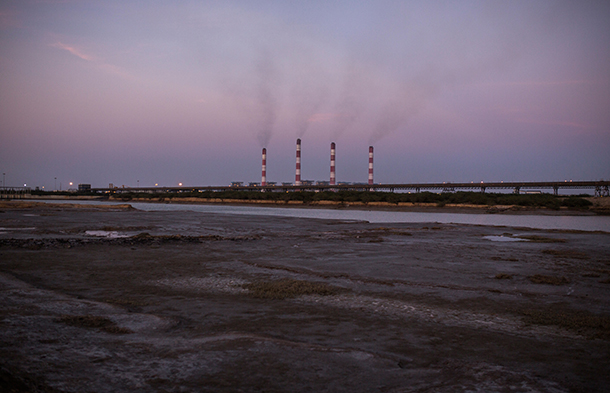
The Mundra Thermal Power Station in the Indian state of Gunjarat is the eleventh largest coal-based thermal power plant in the world. India’s climate goals include weaning itself off of fossil fuels, but as of now, the country is still primarily coal-powered. (Photo: Ariane Wilkinson, Flickr CC BY 2.0)
CURWOOD: Now, someone perhaps in the US or another advanced country will be saying, well, it's alright for India to have a solar and wind, but their intermittent sun doesn't always shine, the wind doesn't always blow. Some electricity is better than none, but really it wouldn't work here because we need electricity 24/7. What's the response?
LEAHY: Well, I did ask the question to the Energy Minister Piyush Goyal, and his answer was, yes, we're going to have coal, we're going to coal to supplement when the wind doesn't blow and the sun isn't shining. We're going to need a combination of energy sources for India's future. But, at the moment, they've said that they're not going to build any new coal plants for probably the next decade. The few that are currently under construction they will complete. After that period of time they are hopeful that they can slowly develop battery storage -- ways of storing renewable intermittent energy -- that technology has been a bit expensive at this point but it's coming along very quickly as well in terms of lower-cost. So, in the future they'll be able to store renewable energy and that will mean they can wean themselves off coal.
CURWOOD: So, how many gigawatts of renewable is India planning to install in this program?
LEAHY: They plan to add 160 gigawatts over the next four years and they may be able to do that even sooner. For comparison, the US into 2015 had just over 100 gigawatts in solar and wind and of course that took several decades to build up to that 100 gigawatts.
CURWOOD: So, if the US doesn't get a move on, India is going to pass the United States, huh?
LEAHY: Yes, they will probably pass the US by the year, 2000, 2022.
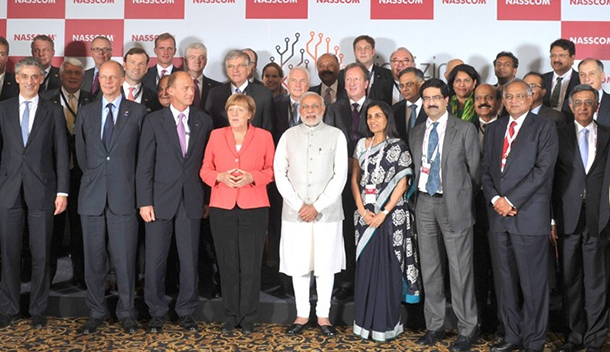
Prime Minister Modi attends a business forum in Bangalore with German Chancellor Angela Merkel in 2015. On Tuesday, Modi reiterated his commitment to partner with German leadership on global green energy policy. (Photo: Narendra Modi, Wikimedia Commons CC BY-SA 2.0)
CURWOOD: Stephen, it seems to me that in a funny kind of way, India has an advantage with so many people without any electricity that they're leap frogging all that the costly infrastructure that we have -- your perception?
LEAHY: Well, they have a driving need to get electricity to people who don't have it and this is true in a lot of developing countries. They want change, they need change, they know they have to make change, so they're willing to put the resources and the urgency into having these things like renewable happen quickly, whereas, industrialized countries are already fairly comfortable, and we don't necessarily see a pressing urgency for change. So, I think that's part of the motivation. Secondarily, they don't need a lot of electricity. They just need a little bit of electricity for lighting to charge their phones. It's not necessary to provide the amount of electricity that the average American enjoys currently.
CURWOOD: What kind of transformation for a villager who had no electricity before does solar and/or wind bring to his village?
LEAHY: It could be huge because now at night instead of having a smokey lantern powered by using kerosene, which has its own hazards. It's a fire hazard. So, now with an LED light, a young student can do his homework in the evenings whereas it would have been too dark or the flickering light would've been also too expensive. LEDs are cheaper than kerosene. So, there's a number of things. They can also look at, well, there are now low-power LED kind of like, flash drive computers that used very little energy, so small little lap tops could be something that can be powered by -- easily powered by solar or wind. So, these are all new things that will be able to be part of the average village in India.
CURWOOD: I imagine with all those things, it'll be a huge leap the middle class for those people.
LEAHY: Yeah, and I think it will also be able to provide lots of services. If you have access to the internet, and you're a farmer, well then you can get a better price for your crops because you'll know what the average selling price is for other regions. So, there's a whole pile of advantages electricity will bring. I mean, let's face it. Who doesn't want to have electricity?

At a marketplace in Mankapur, India, locals inspect an LED lantern as a replacement for kerosene lights. The country has already successfully replaced 235 million household and street lights with LED technology. (Photo: Engineering for Change, Flickr CC BY-SA 2.0)
CURWOOD: So, the top emitters in the world, Stephen, as you know, China and the US and then India. Each country made pledges at Paris. India's plan ... how does this put it on the path to meet its promises at Paris, do you think?
LEAHY: Yeah, India going to meet its Paris commitments. It's going to, according to the latest analysis by scientists, if it is able to pull this off, which is what it's already in the middle of doing -- It will exceed those commitments and for comparison the US is not on track to make its Paris commitments, nor for that matter neither is Canada, unfortunately.
CURWOOD: We should note that you're Canadian.
LEAHY: Yes.
CURWOOD: So Prime Minister Modi has a term that ends, I believe, in 2019. How critical is he in this green energy transformation and how lasting might these policies be if someone else were to take office there?
LEAHY: Well that's an important question. I think Prime Minister Modi has been essential to this transition, and I think by 2019 -- because so many things will have been delivered -- the LED lights, the access to energy for everyone in India, massive amounts of new, renewable energy -- I think it will be too far down the road for India to turn back completely. It's certainly impossible that a new government might reemphasize coal, but I think the general public will have seen the benefits, they will have seen it's real, and they will I think understand that this is where India has to go for its future.
CURWOOD: What can other developing countries learn from India's energy transformation, do you think?
LEAHY: I think they've learned it can happen very quickly, that it's lower cost, and it can provide, like, you know, benefits to people who have not had access to electricity in a very short period of time, one or two years as opposed to a five or 10 year and hyper-expensive megaproject. And it brings real benefits to local people without having some of the downsides of massive infrastructure projects, which can be very disruptive. They won’t have the air pollution issues. They will also be protecting their water resources.
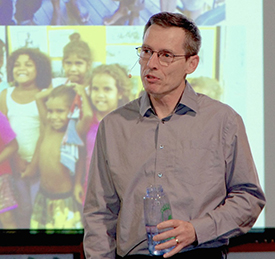
Stephen Leahy is an international environmental journalist. His recent coverage of India’s green energy transformation appeared in National Geographic. (Photo: Stephen Leahy)
CURWOOD: And what about the United States? What can or should the US learn from India's progress on this energy transformation?
LEAHY: Well, I think they should understand that coal is not the answer, going back to coal and that fossil fuels … the day of fuel fuels is over. And that even a country that is a developing country with all sorts of social and other issues can make this rapid transition to renewable energy for the benefit of its citizens, but also for the benefits of this economy. They're building what we call a 21st century economy around renewable.
CURWOOD: Stephen Leahy is an independent journalist covering environmental issues. His most recent reporting on India's renewable energy transformation appeared in National Geographic. Stephen, thanks so much for taking the time with us today.
LEAHY: You're very welcome.
Related links:
- National Geographic: “India Launches Massive Push for Clean Power, Lighting, and Cars”
- Washington Post: “As Merkel seeks allies elsewhere, Modi visits Berlin bursting with friendliness”
- Living on Earth’s coverage of India’s solar commitments at COP21
- Stephen Leahy’s website
[MUSIC: Cyrus Chestnut, “Peace” on Spirit, composed by Horace Silver, Jazz Legacy Productions]
CURWOOD: Next time on Living on Earth, as cocaine injects illicit money into Central America, drug dealers are laundering their revenues by buying up tropical forests.
SESNIE: Clearing forest for cattle is a way to legitimize the profits from cocaine trafficking and put that into a legal economy.
CURWOOD: But this Narco traffic is also driving massive deforestation. That’s next time, on Living on Earth.
EARTH EAR – COSTA RICA
[SFX: MONKEYS CALLING]
CURWOOD: We leave you this week in the rain in Costa Rica, in the Rincon de la Vieja National Park in the northwest.
[SFX: MONKEYS CALLING]
CURWOOD: In the treetops, a troop of golden-mantled howling monkeys calls to each other across the cloud forest.
[SFX: MONKEYS CALLING]
CURWOOD: They’re fairly large monkeys, two to three feet long, and mostly black except for a distinctive golden fringe down their sides. Their diet consists of leaves, and they spend most of their time eating and sleeping.
[SFX: MONKEYS CALLING]
CURWOOD: Andrew Roth recorded these noisy primates for the CD, “Natural Sounds of Costa Rica.”
[MUSIC: Cyrus Chestnut, “Peace” on Spirit, composed by Horace Silver, Jazz Legacy Productions]
CURWOOD: Living on Earth is produced by the World Media Foundation. Our crew includes Naomi Arenberg, Bobby Bascomb, Savannah Christiansen, Jenni Doering, Matt Hoisch, Noble Ingram, Jaime Kaiser, Don Lyman, Alex Metzger, Helen Palmer, Adelaide Chen, and Jolanda Omari. Tom Tiger engineered our show, with help from John Jessoe and Jake Rego. Alison Lirish Dean composed our themes. You can find us anytime at LOE.org -- and like us, please, on our Facebook page -- it’s PRI’s Living on Earth. And we tweet from @LivingonEarth.
I'm Steve Curwood. Thanks for listening.
ANNOUNCER1: Funding for Living on Earth comes you, our listeners, and from the University of Massachusetts, Boston, in association with its School for the Environment, developing the next generation of environmental leaders. And from the Grantham Foundation for the protection of the environment, supporting strategic communications and collaboration in solving the world’s most pressing environmental problems. Support also comes from the Energy Foundation, serving the public interest by helping to build a strong, clean, energy economy, from Carl and Judy Ferenbach of Boston, Massachusetts and from SolarCity, America’s solar power provider. SolarCity is dedicated to revolutionizing the way energy is delivered by giving customers a renewable alternative to fossil fuels. Information at 888-997-1703. That’s 888-997-1703.
ANNOUNCER2: PRI. Public Radio International.
Living on Earth wants to hear from you!
Living on Earth
62 Calef Highway, Suite 212
Lee, NH 03861
Telephone: 617-287-4121
E-mail: comments@loe.org
Newsletter [Click here]
Donate to Living on Earth!
Living on Earth is an independent media program and relies entirely on contributions from listeners and institutions supporting public service. Please donate now to preserve an independent environmental voice.
NewsletterLiving on Earth offers a weekly delivery of the show's rundown to your mailbox. Sign up for our newsletter today!
 Sailors For The Sea: Be the change you want to sea.
Sailors For The Sea: Be the change you want to sea.
 The Grantham Foundation for the Protection of the Environment: Committed to protecting and improving the health of the global environment.
The Grantham Foundation for the Protection of the Environment: Committed to protecting and improving the health of the global environment.
 Contribute to Living on Earth and receive, as our gift to you, an archival print of one of Mark Seth Lender's extraordinary wildlife photographs. Follow the link to see Mark's current collection of photographs.
Contribute to Living on Earth and receive, as our gift to you, an archival print of one of Mark Seth Lender's extraordinary wildlife photographs. Follow the link to see Mark's current collection of photographs.
 Buy a signed copy of Mark Seth Lender's book Smeagull the Seagull & support Living on Earth
Buy a signed copy of Mark Seth Lender's book Smeagull the Seagull & support Living on Earth

